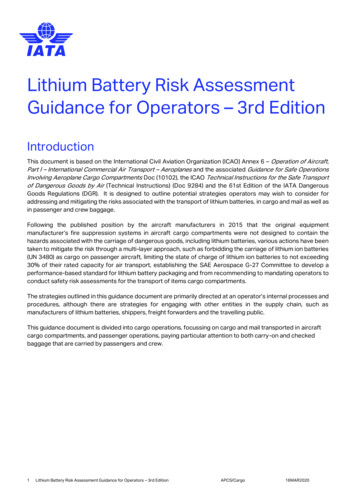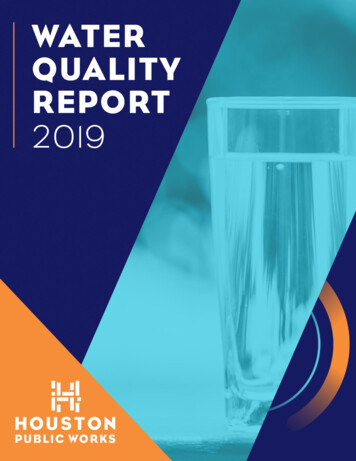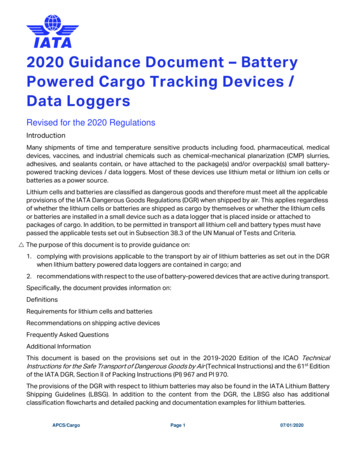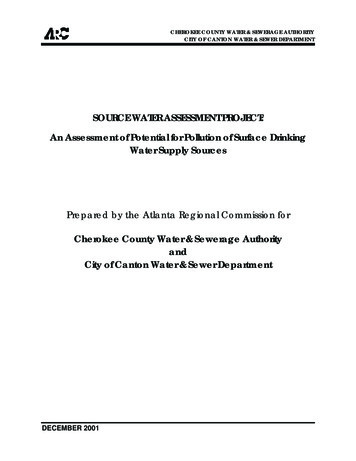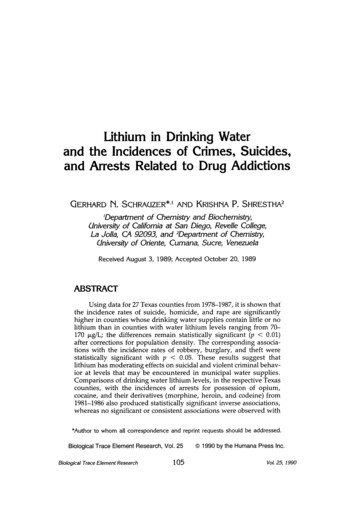
Transcription
Lithium in Drinking Waterand the Incidences of Crimes, Suicides,and Arrests Related to Drug AddictionsGERHARD N.SCHRAUZER *' AND KRISHNA P. S H R E S T H A 2IDepartment of Chemistry and Biochemistry,University of Cah'fomia at San Diego, Revelle College,La Jolla, CA 92093, and Department of Chemistry,University of Oriente, Cumana, Sucre, VenezuelaReceived August 3, 1989; Accepted October 20, 1989ABSTRACTUsing data for 27 Texas counties from 1978-1987, it is shown that'the incidence rates of suicide, homicide, and rape are significantlyhigher in counties whose drinking water supplies contain little or nolithium than in counties with water lithium levels ranging from 70170 I g/L; the differences remain statistically significant (p 0.01)after corrections for population density. The corresponding associations with the incidence rates of robbery, burglary, and theft werestatistically significant with p 0.05. These results suggest thatlithium has moderating effects on suicidal and violent criminal behavior at levels that may be encountered in municipal water supplies.Comparisons of drinking water lithium levels, in the respective Texascounties, with the incidences of arrests for possession of opium,cocaine, and their derivatives (morphine, heroin, and codeine) from1981-1986 also produced statistically significant inverse associations,whereas no significant or consistent associations were observed with*Author to whom all correspondence and reprint requests should be addressed.Biological Trace Element Research, Vol. 25BiologicalTraceElementResearch] 059 1990 by the Humana Press Ino.VoL25, 1990
Schrauzer and Shrestha106the reported arrest rates for possession of marijuana, driving underthe influence of alcohol, and drunkenness. These results suggest thatlithium at low dosage levels has a generally beneficial effect on human behavior, which may be associated with the functions of lithiumas a nutritionally-essential trace element. Subject to confirmation bycontrolled experiments with high-risk populations, increasing thehuman lithium intakes by supplementation, or the lithiation of drinking water is suggested as a possible means of crime, suicide, anddrug-dependency reduction at the individual and community level.Index Entries: Lithium; crime; violent behavior; suicide; druguse; cocaine; heroin; marijuana; morphine; drunkenness; drunk driving; lithium supplementation; drinking water, lithiation of; crimeprevention; suicide prevention; drug dependency, reduction of.INTRODUCTIONLithium is a trace element that appears to be essential for higheranimals (1,2). However, although the element is widely used at pharmacological dosages in the treatment of various mental disorders (3), itseffects at normal nutritional levels have not yet received much attention.Dawson, Moore and McGanity (4) previously compared the lithiumconcentrations in the regional drinking water supplies with the incidenceof admissions and readmissions for psychoses, neuroses, and personality disorders in 27 Texas state mental hospitals and observed a statistically significant inverse relationship. The same authors subsequentlys h o w e d that the homicide rates were also inversely correlated with thelithium levels in the drinking water and the urinary excretion of lithiumby normal residents in their respective areas (5). The associations rem a i n e d significant after consideration of possible confounding variables,such as population density, the distance to the nearest state hospitals,and rainfall. Although rainfall was positively correlated with the countyrates of first mental hospital admission, as well as with homicide rates,rainfall was also found to be inversely correlated with the lithium levelsin the drinking water and the urinary excretion of lithium by healthysubjects, demonstrating a dilution effect of rainfall on the water supplies.With the suicide rates, the association with water lithium levels wasinverse, but did not reach statistical significance. Since incidence data foronly two years, 1967-1969, were used in these studies, we decided toreinvestigate the relationships b e t w e e n drinking water lithium with homicide and suicide rates for 10 years, using data from 1978--1987, andextend the study to other crimes (rapes, robberies, thefts, burglaries,assault, motor vehicle thefts, and the total crime rate). As the addiction tonarcotics may be regarded as a self-destructive trait, which thus couldd e p e n d on the same environmental influences as suicide, comparisonswere also m a d e between the drinking water lithium levels in the respective counties and the incidences of arrests for possession of opium,Biological Trace Element ResearchVol. 25, 1990
107Lithium and Crime and Suicide Ratescocaine, and their derivatives (morphine, heroin, and codeine), andpossession of marijuana, as well as arrests for d r u n k driving and drunkenness, using data from 1981-1986.MATERIALS AND METHODSThe 27 Texas counties of refs. (4,5) w e r e classified into High, Medium, and Low groups according to the lithium content in the municipalwater supplies, with populations of 1986 (in thousand) given in parentheses and the average per capita annual income for 1981:Group A, High (mean Li content 123 25 I g Li/L, range 70-160IIgFL): E1 Paso (579), Lampasas (14), Dimmit (11), Cameron (259),Duval (13), and Hidalgo (377). Average income: 6842 1082;Group B, Medium (mean Li content, 35 - 15 t g/L, range 13-60t g/L): Washington (27), Ector (122), Frio (17), Haskell (7), Jones (17),Nueces (297), and San Patricio (59). Average income: 9,717 2051;Group C, Low (mean Li content, 5 4 tLg/L, range 0-12 I g/L):Dallas (1,874), Tarrant (1,131), Harris (2,782), Bexar (1,187), Wichita(129), Limestone (25), McLennan (191), Travis (559), Anderson (45),Hardin (40), Newton (13), Galveston (209), Guadelupe (60), andUvalde (24). Average income was 9,895 2243; andGroup D. Because Group C contains four counties with largecities, where higher crime rates may be expected on the basis ofpopulation density alone, the analyses were also conducted with thecounties of Group C, excluding Dallas, Tarrant, Harris, and Bexar. Inthis group, the average income was 9,032 1888.County crime incidences w e r e taken from the Annual Crime Reportsissued by the US D e p a r t m e n t of Justice for the years 1978-1987(6) andsuicide mortalities from a n n u a l US vital statistics h a n d b o o k s issued bythe D e p a r t m e n t of Health a n d H u m a n Services (7). Crime rates werecalculated by dividing the c o m b i n e d crime incidences by the total populations per group, as calculated from data from 1978-1987, obtained fromthe Texas D e p a r t m e n t of Health (8).The levels of statistical significance b e t w e e n the m e a n s w e r e determ i n e d by Student's t-test, with Bonferroni correction for multiple comparisons or, w h e r e a time-trend was apparent, by paired t-tests on anIBM-PC, using the biostatistics program developed by S. A. Glantz (9).RESULTSTable 1 shows that the m e a n annual incidence rates of homicide,suicide, rape, robbery, burglary, theft, and total crime during 1978-1987were lower in group A (high-Li counties) than group C (all low-LiBiological Trace Element ResearchVol. 25, 1990
Schrauzer and Shrestha108o. . . . , I ' . .--, . cq ,,- ,.o c.,I Lr a' o O0CL 1 1 1 1 1 1 1 1 lf .- -- t / 3 t / 3 . t,-r3v8 oCLvv z, "o c c II0 .- ZrQJ 1 1 1 1 1 1 1 1 1Z J zzzzzzzzzg.UddMm iMd 1 1 1 1 1 ! 1 1 1oL) J,4.-'Xe!:: .Z.'t'N- ,.-1 o ,' I* . o z: : .U3t b n: &:: ,,9. o :u ,.c:;Biological Trace Element Research or L ,. oVoL 25, 1990
109Lithium and Crime and Suicide RatesTable 2Homicide Rates" in 27 Counties of-Texas, Classified in Four Categories,According to the Lithium Content in the Municipal Drinking Water 87x SDGroup A,High Li(70-160 g/L)5.85.510.67.98.37.95.66.48.26.37.5 1.8Group B,Group C,Group D,Medium Li Low Li (0-12 g g/L), Low Li (0-10 g(13-60 p g/L) all countiesLi/L), low pop. .013.513.711.89.911.210.213.4 3.716.9 2.112.7 2.4"Per 100,000 population.counties); all differences except those for assault were statistically significant (p 0.01).Significant differences in the incidence rates of these crimes werealso observed b e t w e e n high- and low-Li counties with similar populationdensities, as evidenced by the comparisons between the high-Li group Aand low-Li Group D, in which the counties with the four largest cities(Dallas, Houston, Forth Worth, and San Antonio) are excluded. Thedifferences w e r e most significant with the incidences of homicide, rape,and suicide (p 0.01). For example, Table 2 shows that the homiciderates during the decade studied were consistently lower (by 30-50%) inthe high- than the m e d i u m - or low-Li counties. The incidences of robbery, burglary, theft, and the total crime rates were also lower in thehigh-Li counties, but the respective differences involving assault werestatistically insignificant. The associations with motor vehicle (MV) theftwas significant only b e t w e e n Groups A-C, but not b e t w e e n groups A-D,primarily reflecting the higher incidence of MV theft in the large cities ofGroup C.In medium-Li Group B, the suicide and crime rates were, in general,intermediate b e t w e e n those in Groups A and C; but with group D, thecorresponding associations w e r e all not significant. This suggests thatthe lithium levels in group B w e r e possibly below threshold and that therespective counties, arbitrarily assigned to group B, could also have beenplaced into the low-Li Groups C or D.Table 3 indicates that the arrests for possession of drugs (cocaine,morphine, heroin, codeine, opium, and so on) in the years 1981-1986were consistently lower in Group A than in Groups B-D. The incidenceof arrests for d r u g possession increased during the period of observation,Biological Trace Element ResearchVoL 25, 1990
Schrauzer and Shrestha110Cr0,, G3 1 1 I 1O0 b,,.O0ug vRooVVo-,-"I::i. 0*oIIlZU 1 1 1,,oc.iZII%8 P-. m m-4v qO . [.-. . . o.m' M 1 1 1g ol-mm .a **mmm I# ZZZ F-q.ZZ o.o'1 . . . - ,.6 r 9. 1o o" o6 1 1 1mo.8t . o go:oo' o 8 8 Biological Trace Element ResearchVol. 25, 1990
Lithium and Crime and Suicide Rates111more strongly in Groups B-D than in Group A. In contrast, the incidencerates of arrests for possession of marijuana, driving under the influence,and drunkenness revealed either no consistent or only weak associationswith drinking water lithium. No significant or consistent associationsbetween the incidence rates of the crimes and socioeconomic parameters,such as annual income, were observed.DISCUSSIONThe present results suggest a beneficial effect of lithium at nutritional levels, especially on suicidal and violent criminal behavior, and onserious drug addiction. These could be related to the roles of lithium asan essential trace element. No significant or consistent inverse associations of drinking water lithium with the arrest rates for the more commoncrimes of theft, motor vehicle theft, assault, marijuana possession, drunkdriving, or drunkenness were observed. The incidence rates of thesecrimes were very similar in all four groups, except that arrest rates fordrunkenness were higher, for some reason, in Group B. Otherwise, thebasic societal factors determining crime and its enforcement in the fourgroups were very similar.Lithium as the carbonate at therapeutic dosage (300 mg/d) has previously been used to control episodic outbreaks of rage among prisoners(10,11) and in the management of drug abusers (12). Animal experimentshave demonstrated that lithium suppresses the cocaine-induced supersensitivity, as well as the supersensitivity induced by haloperidol, thekindling phenomenon following the chronic application of pentylenetetrazole, a central nervous system stimulant, and head-twitching inresponse to the administration of mescaline (13). Furthermore, lithiumhas been found to decrease distractability by irrelevant stimuli and produce a dose-independent improvement of selective attention to stimulithat provide detailed information about the environment. It preventsbehavioral alterations owing to social isolation, lowers aggressivityowing to confinement in isolated environments, and causes a normalization of spontaneous motor activity (14). The majority of these effects maybe associated with the dampening of phosphoinositide-mediated neurotransmission, which was also suggested to explain the normalizing effects of lithium in treating both mania and depression (15).Since human lithium intakes are extremely variable, the potential forchronically suboptimal intakes exists at the individual and collectivelevel. Thus, although the diet typically provides from 1-2.5 mg Li/d, only25 percent of this amount is bioavailable (16). Since the lithium content offoods is highly variable, some populations could have very low dietarylithium intakes. In other regions, substantial additional amounts oflithium may be obtained from the drinking water. In the high-Li countiesof Texas, for example, adults consuming drinking water with a Li contentof 100 g/L would obtain an extra 200 g of fully bioavailable Li per day.Biological Trace Element ResearchVol. 23, 1990
112Schrauzer and ShresthaSchroeder and Nason (17) previously reported 800 g as the 24 h urinarylithium output of human adults. Although similar urinary Li outputs arereached by adults in the high-Li counties (5), only 1/2 to / as much isexcreted by residents in the low-Li areas, where the total lithium intakesreach only 200 lag/d or less. On the other hand, some subjects may reachlithium intakes of 2 mg/d or more through the regular consumption ofcertain brands of mineral water (18). Since hair appears to be a reliableindicator of lithium status (19), it is interesting to note that lower hairlithium levels have been observed in violent offenders than nonviolentcontrols (20).Because of the large variations of human dietary lithium intakes,controlled experiments with prisoners, drug addicts, or other subjects atrisk of exhibiting aggressive or self-destructive behavior should now beconducted with lithium at dosage levels of about 2 mg/d, either by theaddition of lithium to the drinking water or the administration of lithiumin the form of supplements. It is possible that lithium at this low dosage,after sufficiently long periods of administration, will have a normalizingeffect on behavior and additional beneficial effects in subjects that, assuch, are not clinically mentally ill. In some subjects, higher dosages maybe necessary; the absolute lithium requirements may also be dependenton the total salt intake, the frequency and extent of physical exertion,variations of the clearance rate, and other physiological parameters.Subject to confirmation by controlled studies, low-dose lithium supplementation could become an effective method of violence reduction ininstitutionalized subjects. In the general population, the lithiation of thecommunal drinking water supplies could provide a simple, safe, andeconomical means of reducing the incidences of violent crimes, suicides,and the use of narcotic drugs.ACKNOWLEDGMENTSupport for this work by the Wacker Foundation, Dallas, Texas, isgratefully acknowledged.REFERENCES1. M. Anke, B. Groppel, H. Kronemann, and M. Gruen, "Evidence for theEssentiality of Lithium in Goats," Lithium. Proc. 4. Spurenelement symposium1983, M. Anke, W. Baumann, H. Braeunlich, and C. C. Brueckner, eds.,Leipzig, DDR, 1983, pp. 58-63.2. E. E. Pickett, Evidence for the Essentiality of Lithium in the Rat, Lithium (see,ref. 1), loc cit., pp. 66--70.3. J. W. Jefferson, J. H. Greist, and M. Baudhuin, Lithium Current Applicationsin Science, Medicine and Technology, R. E. Bach, ed., Wiley, New York, 1985,pp. 345--352.Biological TraceElement ResearchVol.25, 1990
Lithium and Crime and Suicide Rates1134. E. E. Dawson, T. D. Moore, and W. J. McGanity, Dis. Nerv. Syst. 31, 1(1970).5. E. B. Dawson, T. D. Moore, and W. J. McGanity, Dis. Nerv. Syst. 33, 546(1972).6. Texas Crime Reports 1978-1987, Annual Reports compiled by the Uniform CrimeReporting Bureau, Identification and Criminal Records Division, Texas Department of Public Safety, 5805 N. Lamar Blvd., Austin, TX 787657. Vital Statistics of the United States, Mortality for 1978-1987, US Departmentof Health and Human Services, Public Health Service, National Center forHealth Statistics, Hyattsville, MD.8. Total Population Summary Tables, Texas Counties, 1970--2000, Texas Department of Health Population Data System, Austin, TX, 78765.9. S. A. Glantz, Primer of Biostatistics, McGraw-Hill, New York, 1988.10. M. H. Sheard, Nature (London) 230, 1134 (1971).11. M. H. Sheard, J. Nerv. Mental Dis. 160, 108 (1975).12. B. Hubbard, L. L. Judd, and R. Avery, Inter. J. Addict. 13, 383 (1978).13. J. Oehler, J. Schmidt, and M. Jaehkel, "Zum Einfluss yon Lithium aufadaptive Veraenderungen aminerger Transmission," Proc. 4th Trace ElementSymposium (see, Ref. 1), loc cit., pp. 237-244.14. P. Cappeliez, Mengen und Spurenelemente, 1984, M. Anke, W. Baumann, andH. Braeunlich, eds., pp. 531-536. Karl Marx University, Leipzig, DDR.,1984.15. P. F. Worley, W. A. Heller, S. H. Snyder, and J. M. Baraban, Science(Washington) 239, 1428 (1988).16. B. Flaschentraeger and E. Lehnartz, Physiol. Chemie, Vol. 2, part 1, SpringerVerlag, Berlin, 1954, p. 683.17. H. A. Schroeder and A. P. Nason, Clin. Chem. 17, 461 (1971).18. H. E. Allen, M. A. Halley-Henderson, and C. N. Hass, Arch. Env. Health 44,102 (1989).19. H. Kronemann, M. Anke, B. Groppel, and E. Riedel, "The capacity oforgans to indicate the lithium level," Proc. 4th Trace Elements Symposium(see ref. 1), opus loc. cit., pp. 85-89.20. P. E. Cromwell, B., R. Abadie, J. T. Stephens, and M., Kyler, Psychol.Reports 64, 259 (1989).Biological Trace Element ResearchVoL 25, 1990
University of Cah'fomia at San Diego, Revelle College, La Jolla, CA 92093, and Department of Chemistry, University of Oriente, Cumana, Sucre, Venezuela Received August 3, 1989; Accepted October 20, 1989 ABSTRACT Using data for 27 Texas counties from 1978-1987, it is shown that'
